PPMP20009: Analysis of Project Management for FIFA World Cup 2018
VerifiedAdded on 2023/06/07
|13
|2879
|455
Report
AI Summary
This report provides a comprehensive analysis of project management methodologies applicable to the FIFA World Cup 2018, focusing on the implementation of lean principles. The report begins by defining and elaborating on the Voice of the Customer (VOC), Critical to Customer Requirements (CCR), and Critical to Quality parameters (CTQ) within the context of the event. It then outlines a practical approach to implementing lean project management for the World Cup, emphasizing the importance of customer satisfaction and waste reduction. Furthermore, the report identifies and elaborates on key processes from various project management methodologies, including PMBOK, PRINCE2, Organisational Project Management, Agile Practices, and Lean Six Sigma (DMAIC Methodology), demonstrating how each can support the successful and efficient execution of the event. The analysis includes detailed descriptions of each methodology's processes and their relevance to the specific challenges and objectives of organizing a large-scale international sporting event like the FIFA World Cup. The report provides a structured and insightful overview, offering valuable perspectives on project management best practices.
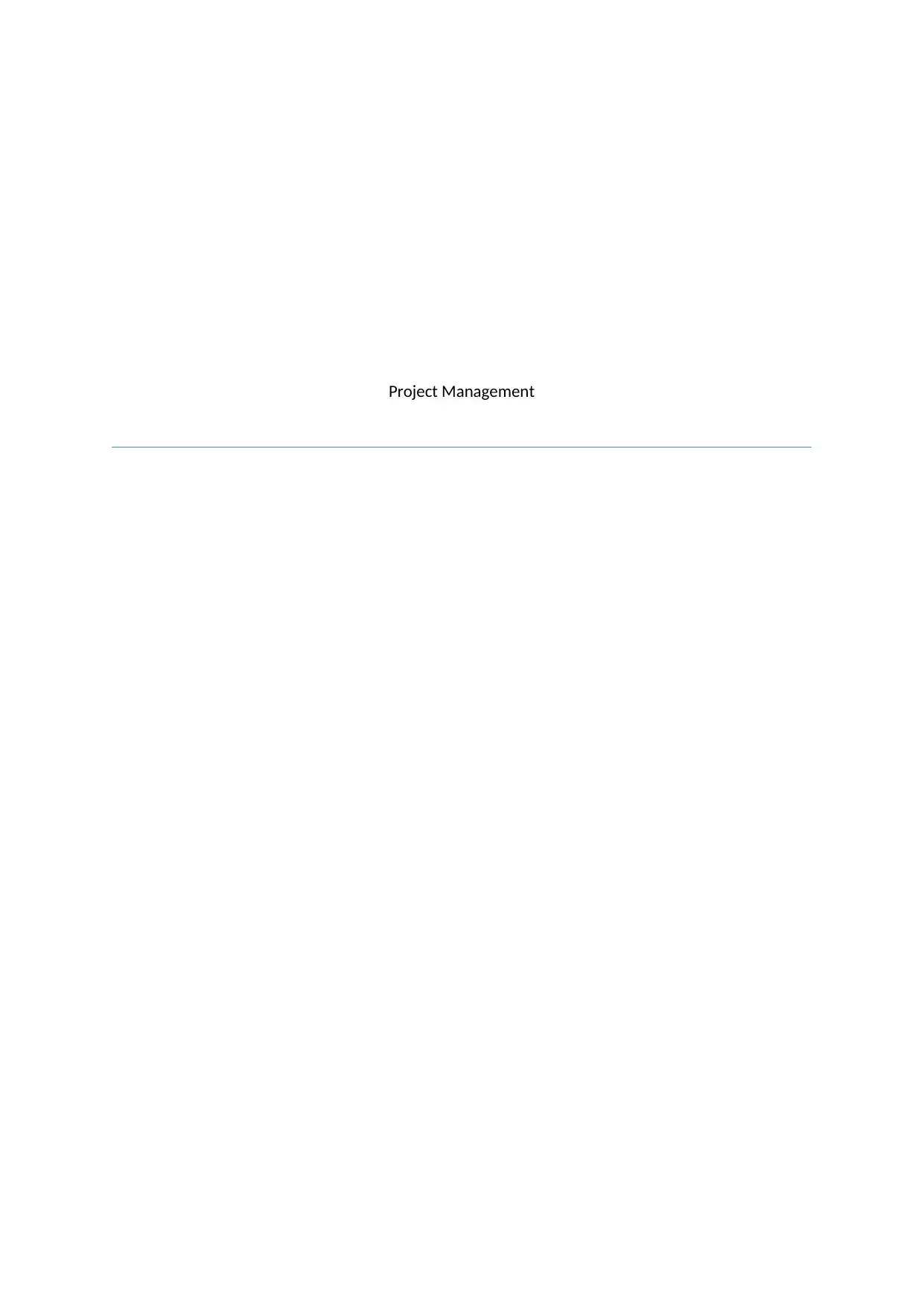
Project Management
Paraphrase This Document
Need a fresh take? Get an instant paraphrase of this document with our AI Paraphraser

Contents
Project Overview...................................................................................................................................2
Voice of the customers..........................................................................................................................2
Critical to customer requirement...........................................................................................................2
Critical to quality parameters.................................................................................................................3
Process of implementing the lean project management methodology for the project............................4
Identification and elaboration of project management methodologies...................................................5
References:..........................................................................................................................................10
Project Overview...................................................................................................................................2
Voice of the customers..........................................................................................................................2
Critical to customer requirement...........................................................................................................2
Critical to quality parameters.................................................................................................................3
Process of implementing the lean project management methodology for the project............................4
Identification and elaboration of project management methodologies...................................................5
References:..........................................................................................................................................10
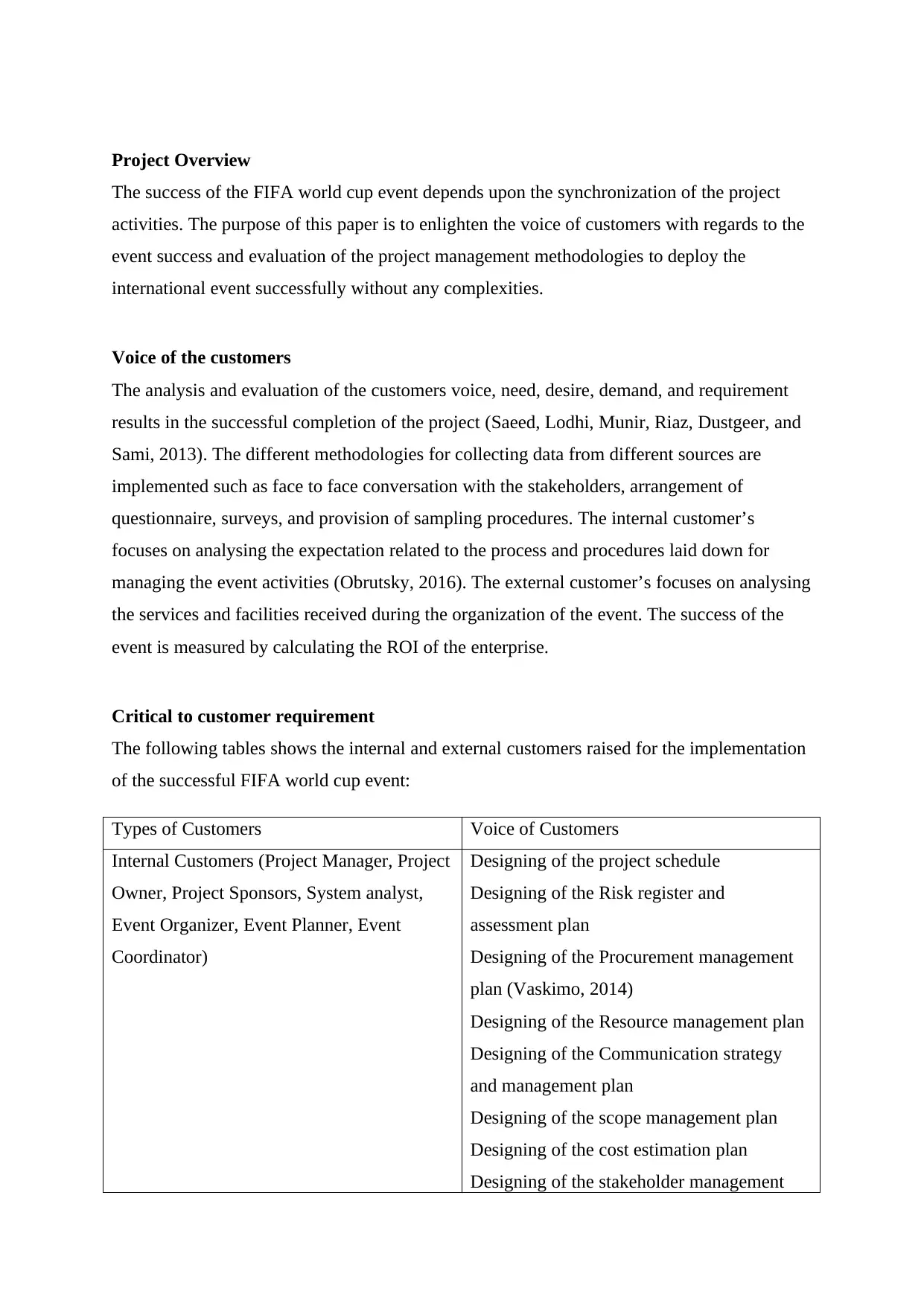
Project Overview
The success of the FIFA world cup event depends upon the synchronization of the project
activities. The purpose of this paper is to enlighten the voice of customers with regards to the
event success and evaluation of the project management methodologies to deploy the
international event successfully without any complexities.
Voice of the customers
The analysis and evaluation of the customers voice, need, desire, demand, and requirement
results in the successful completion of the project (Saeed, Lodhi, Munir, Riaz, Dustgeer, and
Sami, 2013). The different methodologies for collecting data from different sources are
implemented such as face to face conversation with the stakeholders, arrangement of
questionnaire, surveys, and provision of sampling procedures. The internal customer’s
focuses on analysing the expectation related to the process and procedures laid down for
managing the event activities (Obrutsky, 2016). The external customer’s focuses on analysing
the services and facilities received during the organization of the event. The success of the
event is measured by calculating the ROI of the enterprise.
Critical to customer requirement
The following tables shows the internal and external customers raised for the implementation
of the successful FIFA world cup event:
Types of Customers Voice of Customers
Internal Customers (Project Manager, Project
Owner, Project Sponsors, System analyst,
Event Organizer, Event Planner, Event
Coordinator)
Designing of the project schedule
Designing of the Risk register and
assessment plan
Designing of the Procurement management
plan (Vaskimo, 2014)
Designing of the Resource management plan
Designing of the Communication strategy
and management plan
Designing of the scope management plan
Designing of the cost estimation plan
Designing of the stakeholder management
The success of the FIFA world cup event depends upon the synchronization of the project
activities. The purpose of this paper is to enlighten the voice of customers with regards to the
event success and evaluation of the project management methodologies to deploy the
international event successfully without any complexities.
Voice of the customers
The analysis and evaluation of the customers voice, need, desire, demand, and requirement
results in the successful completion of the project (Saeed, Lodhi, Munir, Riaz, Dustgeer, and
Sami, 2013). The different methodologies for collecting data from different sources are
implemented such as face to face conversation with the stakeholders, arrangement of
questionnaire, surveys, and provision of sampling procedures. The internal customer’s
focuses on analysing the expectation related to the process and procedures laid down for
managing the event activities (Obrutsky, 2016). The external customer’s focuses on analysing
the services and facilities received during the organization of the event. The success of the
event is measured by calculating the ROI of the enterprise.
Critical to customer requirement
The following tables shows the internal and external customers raised for the implementation
of the successful FIFA world cup event:
Types of Customers Voice of Customers
Internal Customers (Project Manager, Project
Owner, Project Sponsors, System analyst,
Event Organizer, Event Planner, Event
Coordinator)
Designing of the project schedule
Designing of the Risk register and
assessment plan
Designing of the Procurement management
plan (Vaskimo, 2014)
Designing of the Resource management plan
Designing of the Communication strategy
and management plan
Designing of the scope management plan
Designing of the cost estimation plan
Designing of the stakeholder management
⊘ This is a preview!⊘
Do you want full access?
Subscribe today to unlock all pages.

Trusted by 1+ million students worldwide
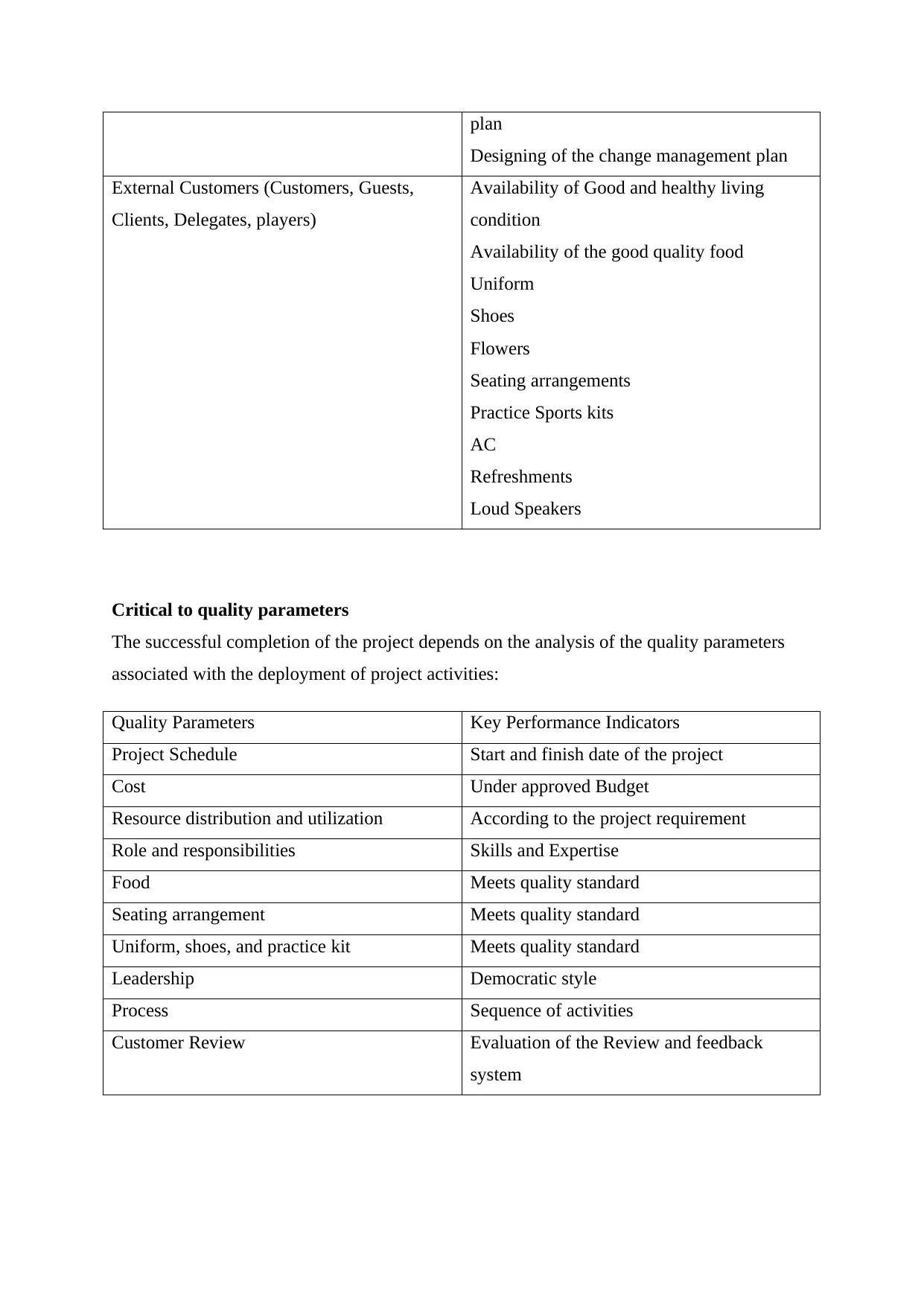
plan
Designing of the change management plan
External Customers (Customers, Guests,
Clients, Delegates, players)
Availability of Good and healthy living
condition
Availability of the good quality food
Uniform
Shoes
Flowers
Seating arrangements
Practice Sports kits
AC
Refreshments
Loud Speakers
Critical to quality parameters
The successful completion of the project depends on the analysis of the quality parameters
associated with the deployment of project activities:
Quality Parameters Key Performance Indicators
Project Schedule Start and finish date of the project
Cost Under approved Budget
Resource distribution and utilization According to the project requirement
Role and responsibilities Skills and Expertise
Food Meets quality standard
Seating arrangement Meets quality standard
Uniform, shoes, and practice kit Meets quality standard
Leadership Democratic style
Process Sequence of activities
Customer Review Evaluation of the Review and feedback
system
Designing of the change management plan
External Customers (Customers, Guests,
Clients, Delegates, players)
Availability of Good and healthy living
condition
Availability of the good quality food
Uniform
Shoes
Flowers
Seating arrangements
Practice Sports kits
AC
Refreshments
Loud Speakers
Critical to quality parameters
The successful completion of the project depends on the analysis of the quality parameters
associated with the deployment of project activities:
Quality Parameters Key Performance Indicators
Project Schedule Start and finish date of the project
Cost Under approved Budget
Resource distribution and utilization According to the project requirement
Role and responsibilities Skills and Expertise
Food Meets quality standard
Seating arrangement Meets quality standard
Uniform, shoes, and practice kit Meets quality standard
Leadership Democratic style
Process Sequence of activities
Customer Review Evaluation of the Review and feedback
system
Paraphrase This Document
Need a fresh take? Get an instant paraphrase of this document with our AI Paraphraser
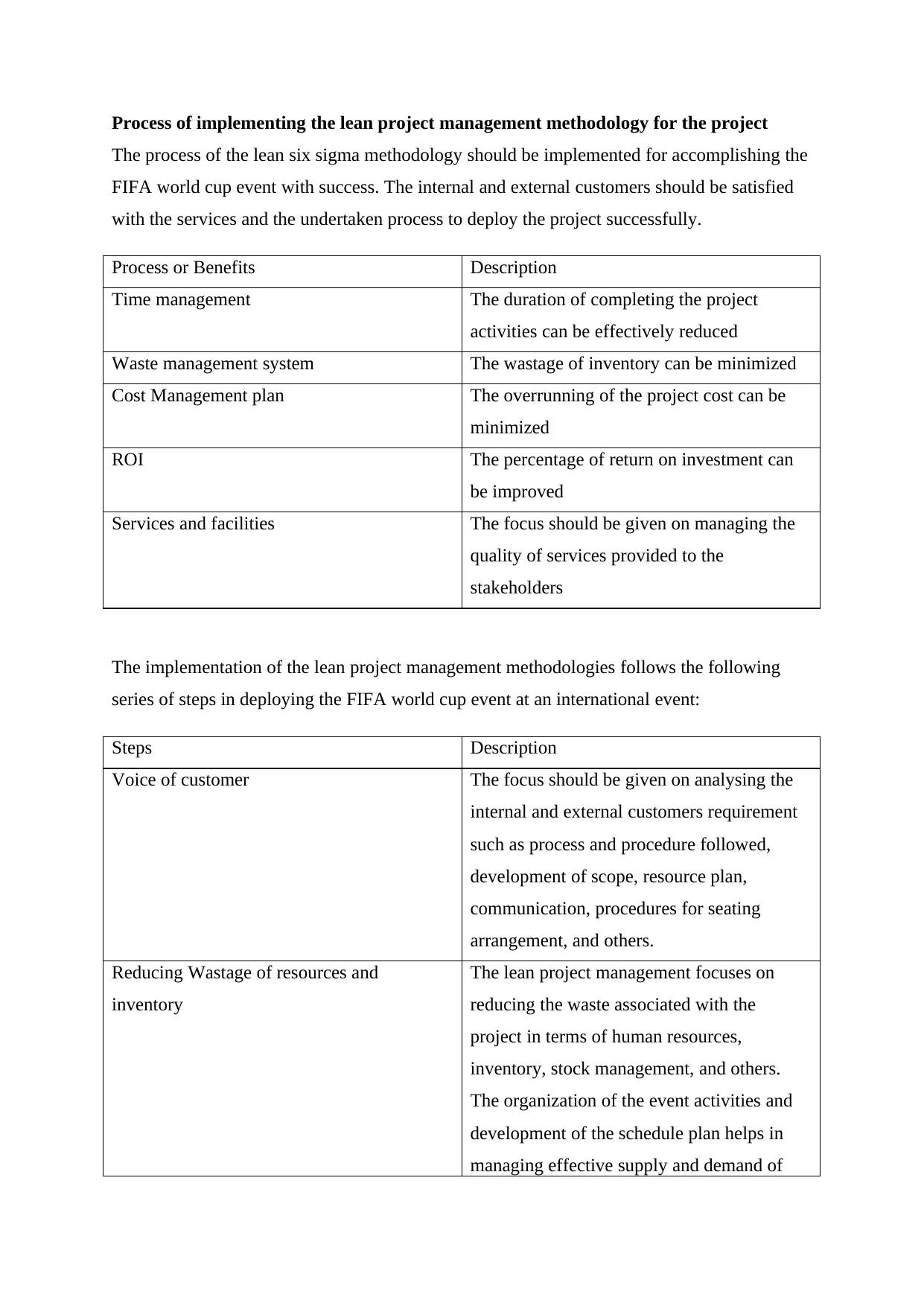
Process of implementing the lean project management methodology for the project
The process of the lean six sigma methodology should be implemented for accomplishing the
FIFA world cup event with success. The internal and external customers should be satisfied
with the services and the undertaken process to deploy the project successfully.
Process or Benefits Description
Time management The duration of completing the project
activities can be effectively reduced
Waste management system The wastage of inventory can be minimized
Cost Management plan The overrunning of the project cost can be
minimized
ROI The percentage of return on investment can
be improved
Services and facilities The focus should be given on managing the
quality of services provided to the
stakeholders
The implementation of the lean project management methodologies follows the following
series of steps in deploying the FIFA world cup event at an international event:
Steps Description
Voice of customer The focus should be given on analysing the
internal and external customers requirement
such as process and procedure followed,
development of scope, resource plan,
communication, procedures for seating
arrangement, and others.
Reducing Wastage of resources and
inventory
The lean project management focuses on
reducing the waste associated with the
project in terms of human resources,
inventory, stock management, and others.
The organization of the event activities and
development of the schedule plan helps in
managing effective supply and demand of
The process of the lean six sigma methodology should be implemented for accomplishing the
FIFA world cup event with success. The internal and external customers should be satisfied
with the services and the undertaken process to deploy the project successfully.
Process or Benefits Description
Time management The duration of completing the project
activities can be effectively reduced
Waste management system The wastage of inventory can be minimized
Cost Management plan The overrunning of the project cost can be
minimized
ROI The percentage of return on investment can
be improved
Services and facilities The focus should be given on managing the
quality of services provided to the
stakeholders
The implementation of the lean project management methodologies follows the following
series of steps in deploying the FIFA world cup event at an international event:
Steps Description
Voice of customer The focus should be given on analysing the
internal and external customers requirement
such as process and procedure followed,
development of scope, resource plan,
communication, procedures for seating
arrangement, and others.
Reducing Wastage of resources and
inventory
The lean project management focuses on
reducing the waste associated with the
project in terms of human resources,
inventory, stock management, and others.
The organization of the event activities and
development of the schedule plan helps in
managing effective supply and demand of
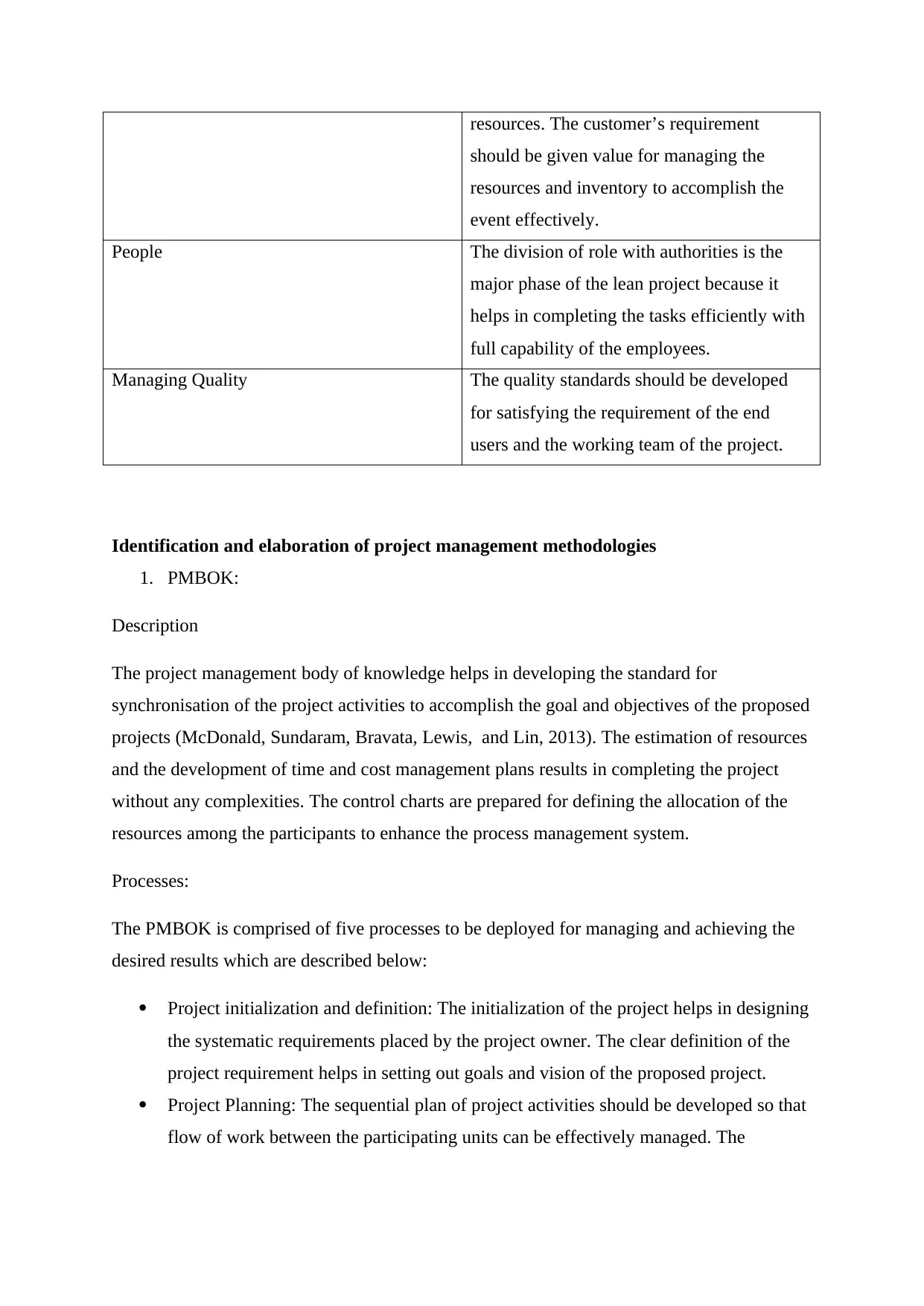
resources. The customer’s requirement
should be given value for managing the
resources and inventory to accomplish the
event effectively.
People The division of role with authorities is the
major phase of the lean project because it
helps in completing the tasks efficiently with
full capability of the employees.
Managing Quality The quality standards should be developed
for satisfying the requirement of the end
users and the working team of the project.
Identification and elaboration of project management methodologies
1. PMBOK:
Description
The project management body of knowledge helps in developing the standard for
synchronisation of the project activities to accomplish the goal and objectives of the proposed
projects (McDonald, Sundaram, Bravata, Lewis, and Lin, 2013). The estimation of resources
and the development of time and cost management plans results in completing the project
without any complexities. The control charts are prepared for defining the allocation of the
resources among the participants to enhance the process management system.
Processes:
The PMBOK is comprised of five processes to be deployed for managing and achieving the
desired results which are described below:
Project initialization and definition: The initialization of the project helps in designing
the systematic requirements placed by the project owner. The clear definition of the
project requirement helps in setting out goals and vision of the proposed project.
Project Planning: The sequential plan of project activities should be developed so that
flow of work between the participating units can be effectively managed. The
should be given value for managing the
resources and inventory to accomplish the
event effectively.
People The division of role with authorities is the
major phase of the lean project because it
helps in completing the tasks efficiently with
full capability of the employees.
Managing Quality The quality standards should be developed
for satisfying the requirement of the end
users and the working team of the project.
Identification and elaboration of project management methodologies
1. PMBOK:
Description
The project management body of knowledge helps in developing the standard for
synchronisation of the project activities to accomplish the goal and objectives of the proposed
projects (McDonald, Sundaram, Bravata, Lewis, and Lin, 2013). The estimation of resources
and the development of time and cost management plans results in completing the project
without any complexities. The control charts are prepared for defining the allocation of the
resources among the participants to enhance the process management system.
Processes:
The PMBOK is comprised of five processes to be deployed for managing and achieving the
desired results which are described below:
Project initialization and definition: The initialization of the project helps in designing
the systematic requirements placed by the project owner. The clear definition of the
project requirement helps in setting out goals and vision of the proposed project.
Project Planning: The sequential plan of project activities should be developed so that
flow of work between the participating units can be effectively managed. The
⊘ This is a preview!⊘
Do you want full access?
Subscribe today to unlock all pages.

Trusted by 1+ million students worldwide
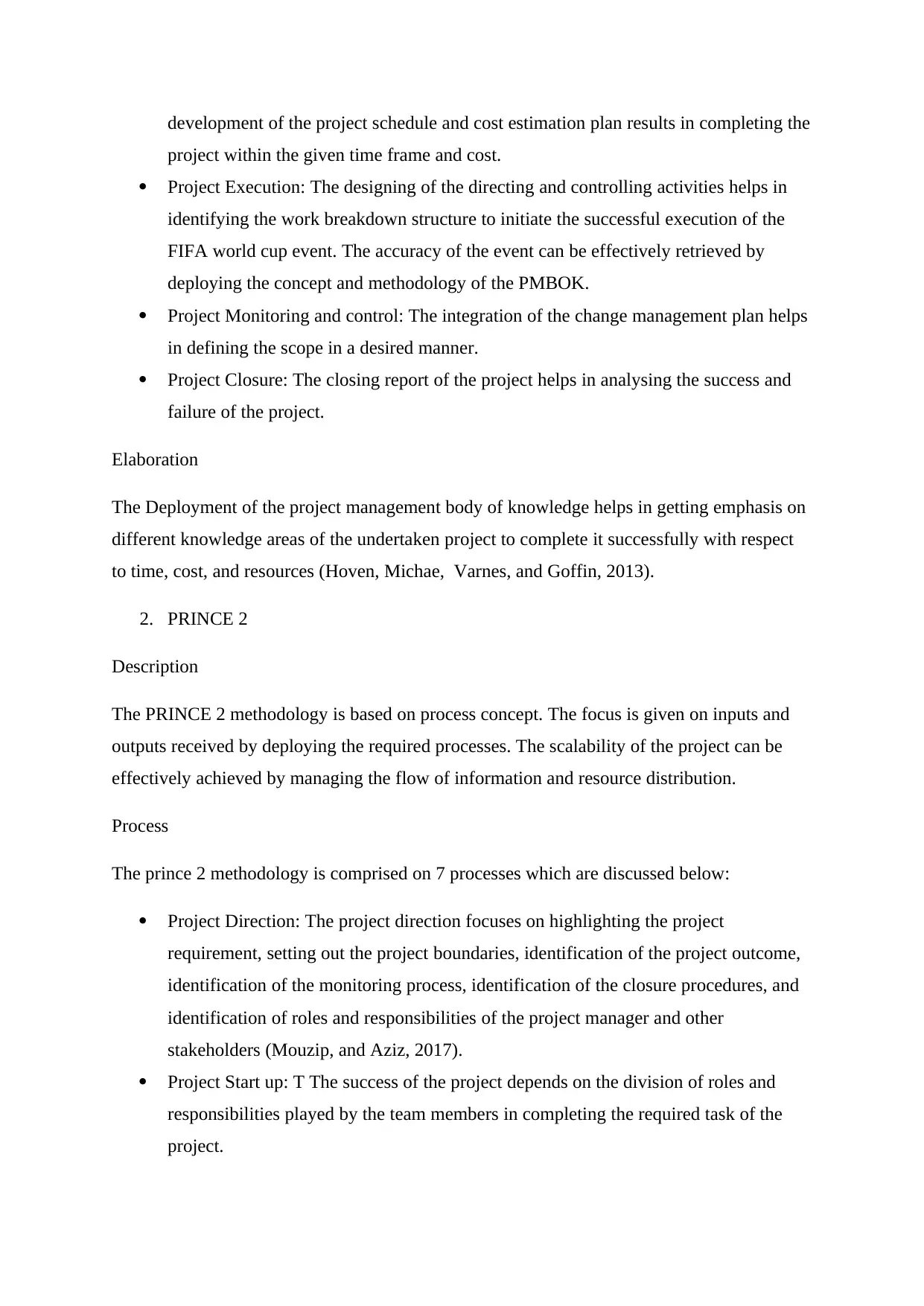
development of the project schedule and cost estimation plan results in completing the
project within the given time frame and cost.
Project Execution: The designing of the directing and controlling activities helps in
identifying the work breakdown structure to initiate the successful execution of the
FIFA world cup event. The accuracy of the event can be effectively retrieved by
deploying the concept and methodology of the PMBOK.
Project Monitoring and control: The integration of the change management plan helps
in defining the scope in a desired manner.
Project Closure: The closing report of the project helps in analysing the success and
failure of the project.
Elaboration
The Deployment of the project management body of knowledge helps in getting emphasis on
different knowledge areas of the undertaken project to complete it successfully with respect
to time, cost, and resources (Hoven, Michae, Varnes, and Goffin, 2013).
2. PRINCE 2
Description
The PRINCE 2 methodology is based on process concept. The focus is given on inputs and
outputs received by deploying the required processes. The scalability of the project can be
effectively achieved by managing the flow of information and resource distribution.
Process
The prince 2 methodology is comprised on 7 processes which are discussed below:
Project Direction: The project direction focuses on highlighting the project
requirement, setting out the project boundaries, identification of the project outcome,
identification of the monitoring process, identification of the closure procedures, and
identification of roles and responsibilities of the project manager and other
stakeholders (Mouzip, and Aziz, 2017).
Project Start up: T The success of the project depends on the division of roles and
responsibilities played by the team members in completing the required task of the
project.
project within the given time frame and cost.
Project Execution: The designing of the directing and controlling activities helps in
identifying the work breakdown structure to initiate the successful execution of the
FIFA world cup event. The accuracy of the event can be effectively retrieved by
deploying the concept and methodology of the PMBOK.
Project Monitoring and control: The integration of the change management plan helps
in defining the scope in a desired manner.
Project Closure: The closing report of the project helps in analysing the success and
failure of the project.
Elaboration
The Deployment of the project management body of knowledge helps in getting emphasis on
different knowledge areas of the undertaken project to complete it successfully with respect
to time, cost, and resources (Hoven, Michae, Varnes, and Goffin, 2013).
2. PRINCE 2
Description
The PRINCE 2 methodology is based on process concept. The focus is given on inputs and
outputs received by deploying the required processes. The scalability of the project can be
effectively achieved by managing the flow of information and resource distribution.
Process
The prince 2 methodology is comprised on 7 processes which are discussed below:
Project Direction: The project direction focuses on highlighting the project
requirement, setting out the project boundaries, identification of the project outcome,
identification of the monitoring process, identification of the closure procedures, and
identification of roles and responsibilities of the project manager and other
stakeholders (Mouzip, and Aziz, 2017).
Project Start up: T The success of the project depends on the division of roles and
responsibilities played by the team members in completing the required task of the
project.
Paraphrase This Document
Need a fresh take? Get an instant paraphrase of this document with our AI Paraphraser
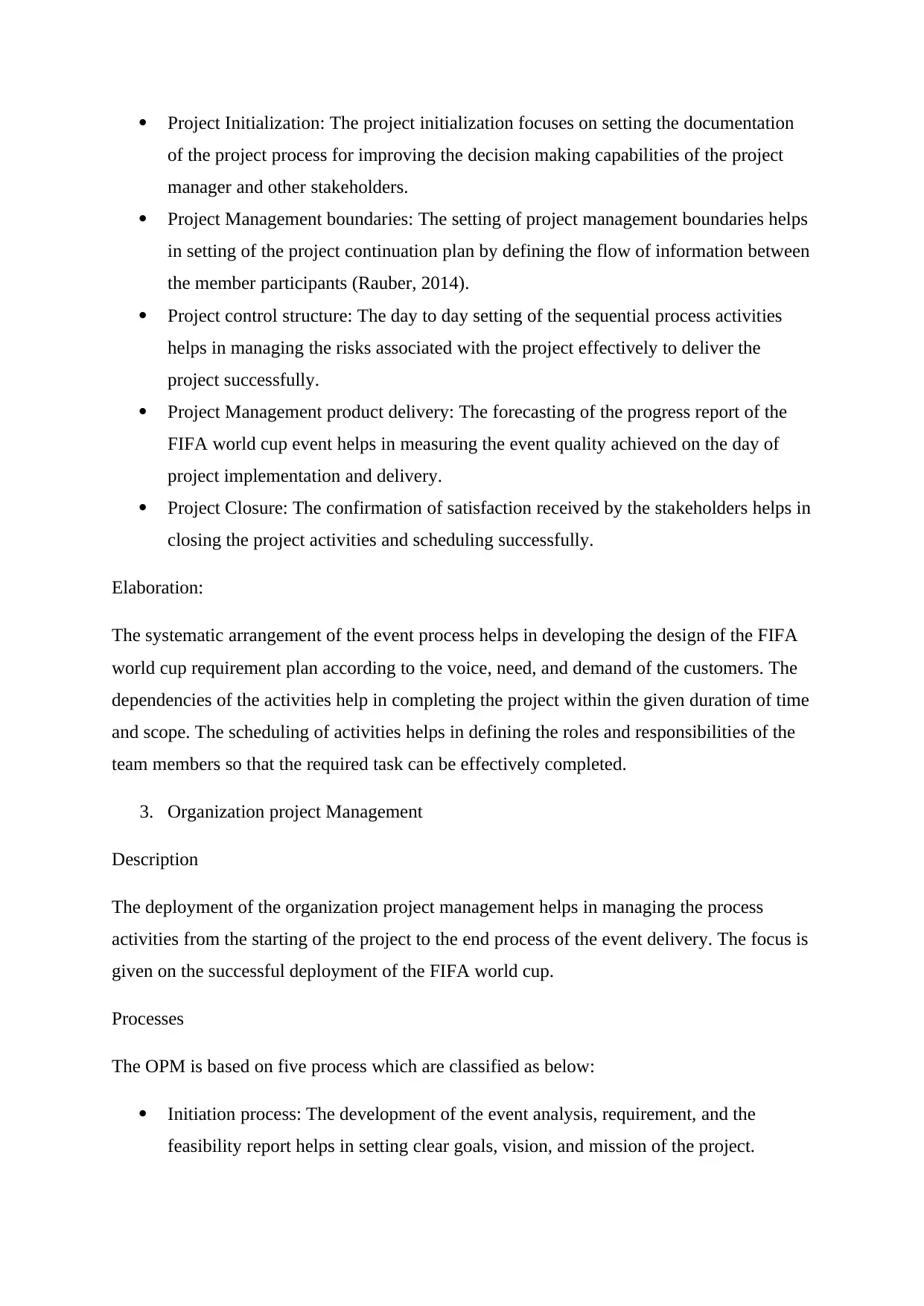
Project Initialization: The project initialization focuses on setting the documentation
of the project process for improving the decision making capabilities of the project
manager and other stakeholders.
Project Management boundaries: The setting of project management boundaries helps
in setting of the project continuation plan by defining the flow of information between
the member participants (Rauber, 2014).
Project control structure: The day to day setting of the sequential process activities
helps in managing the risks associated with the project effectively to deliver the
project successfully.
Project Management product delivery: The forecasting of the progress report of the
FIFA world cup event helps in measuring the event quality achieved on the day of
project implementation and delivery.
Project Closure: The confirmation of satisfaction received by the stakeholders helps in
closing the project activities and scheduling successfully.
Elaboration:
The systematic arrangement of the event process helps in developing the design of the FIFA
world cup requirement plan according to the voice, need, and demand of the customers. The
dependencies of the activities help in completing the project within the given duration of time
and scope. The scheduling of activities helps in defining the roles and responsibilities of the
team members so that the required task can be effectively completed.
3. Organization project Management
Description
The deployment of the organization project management helps in managing the process
activities from the starting of the project to the end process of the event delivery. The focus is
given on the successful deployment of the FIFA world cup.
Processes
The OPM is based on five process which are classified as below:
Initiation process: The development of the event analysis, requirement, and the
feasibility report helps in setting clear goals, vision, and mission of the project.
of the project process for improving the decision making capabilities of the project
manager and other stakeholders.
Project Management boundaries: The setting of project management boundaries helps
in setting of the project continuation plan by defining the flow of information between
the member participants (Rauber, 2014).
Project control structure: The day to day setting of the sequential process activities
helps in managing the risks associated with the project effectively to deliver the
project successfully.
Project Management product delivery: The forecasting of the progress report of the
FIFA world cup event helps in measuring the event quality achieved on the day of
project implementation and delivery.
Project Closure: The confirmation of satisfaction received by the stakeholders helps in
closing the project activities and scheduling successfully.
Elaboration:
The systematic arrangement of the event process helps in developing the design of the FIFA
world cup requirement plan according to the voice, need, and demand of the customers. The
dependencies of the activities help in completing the project within the given duration of time
and scope. The scheduling of activities helps in defining the roles and responsibilities of the
team members so that the required task can be effectively completed.
3. Organization project Management
Description
The deployment of the organization project management helps in managing the process
activities from the starting of the project to the end process of the event delivery. The focus is
given on the successful deployment of the FIFA world cup.
Processes
The OPM is based on five process which are classified as below:
Initiation process: The development of the event analysis, requirement, and the
feasibility report helps in setting clear goals, vision, and mission of the project.
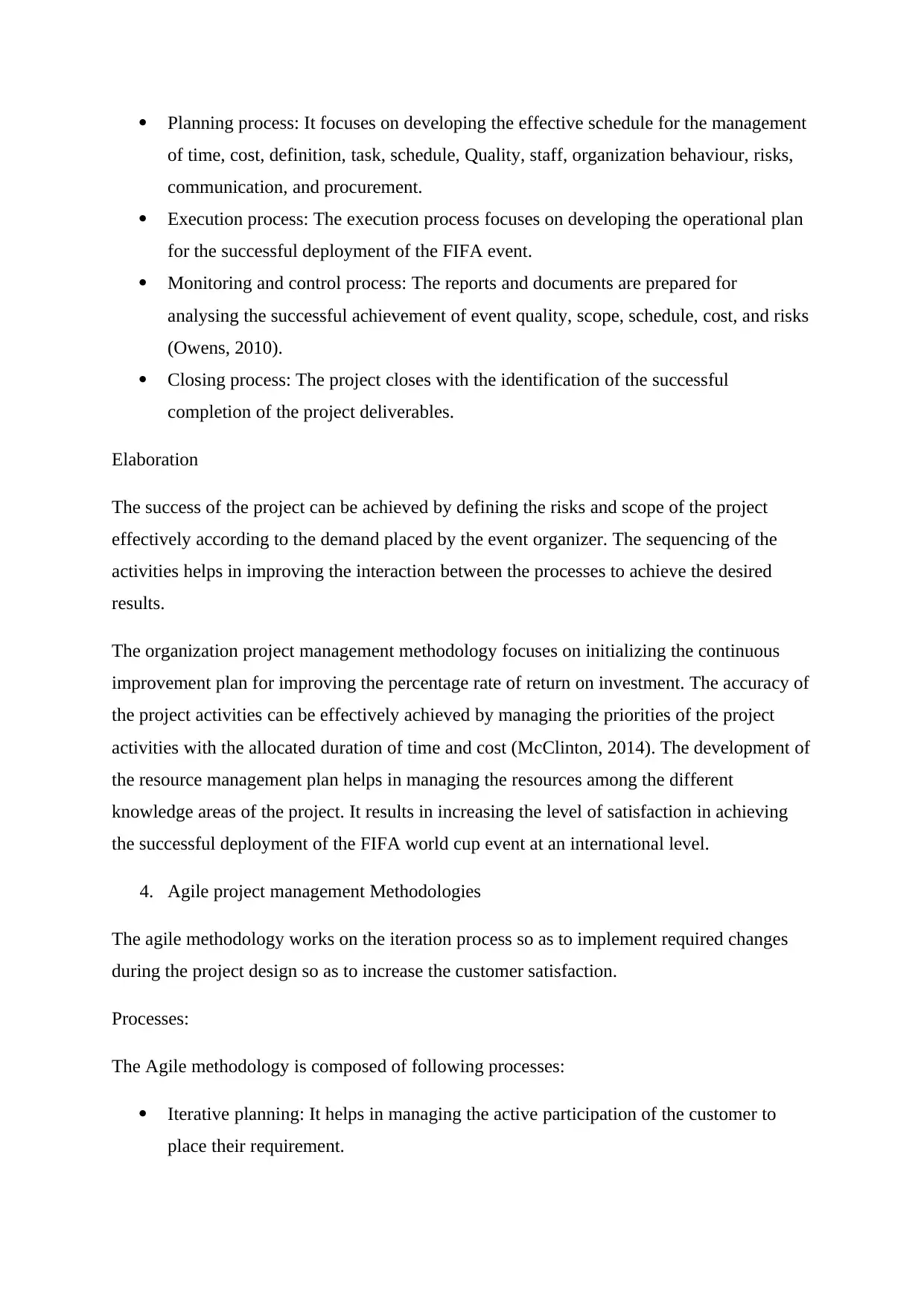
Planning process: It focuses on developing the effective schedule for the management
of time, cost, definition, task, schedule, Quality, staff, organization behaviour, risks,
communication, and procurement.
Execution process: The execution process focuses on developing the operational plan
for the successful deployment of the FIFA event.
Monitoring and control process: The reports and documents are prepared for
analysing the successful achievement of event quality, scope, schedule, cost, and risks
(Owens, 2010).
Closing process: The project closes with the identification of the successful
completion of the project deliverables.
Elaboration
The success of the project can be achieved by defining the risks and scope of the project
effectively according to the demand placed by the event organizer. The sequencing of the
activities helps in improving the interaction between the processes to achieve the desired
results.
The organization project management methodology focuses on initializing the continuous
improvement plan for improving the percentage rate of return on investment. The accuracy of
the project activities can be effectively achieved by managing the priorities of the project
activities with the allocated duration of time and cost (McClinton, 2014). The development of
the resource management plan helps in managing the resources among the different
knowledge areas of the project. It results in increasing the level of satisfaction in achieving
the successful deployment of the FIFA world cup event at an international level.
4. Agile project management Methodologies
The agile methodology works on the iteration process so as to implement required changes
during the project design so as to increase the customer satisfaction.
Processes:
The Agile methodology is composed of following processes:
Iterative planning: It helps in managing the active participation of the customer to
place their requirement.
of time, cost, definition, task, schedule, Quality, staff, organization behaviour, risks,
communication, and procurement.
Execution process: The execution process focuses on developing the operational plan
for the successful deployment of the FIFA event.
Monitoring and control process: The reports and documents are prepared for
analysing the successful achievement of event quality, scope, schedule, cost, and risks
(Owens, 2010).
Closing process: The project closes with the identification of the successful
completion of the project deliverables.
Elaboration
The success of the project can be achieved by defining the risks and scope of the project
effectively according to the demand placed by the event organizer. The sequencing of the
activities helps in improving the interaction between the processes to achieve the desired
results.
The organization project management methodology focuses on initializing the continuous
improvement plan for improving the percentage rate of return on investment. The accuracy of
the project activities can be effectively achieved by managing the priorities of the project
activities with the allocated duration of time and cost (McClinton, 2014). The development of
the resource management plan helps in managing the resources among the different
knowledge areas of the project. It results in increasing the level of satisfaction in achieving
the successful deployment of the FIFA world cup event at an international level.
4. Agile project management Methodologies
The agile methodology works on the iteration process so as to implement required changes
during the project design so as to increase the customer satisfaction.
Processes:
The Agile methodology is composed of following processes:
Iterative planning: It helps in managing the active participation of the customer to
place their requirement.
⊘ This is a preview!⊘
Do you want full access?
Subscribe today to unlock all pages.

Trusted by 1+ million students worldwide
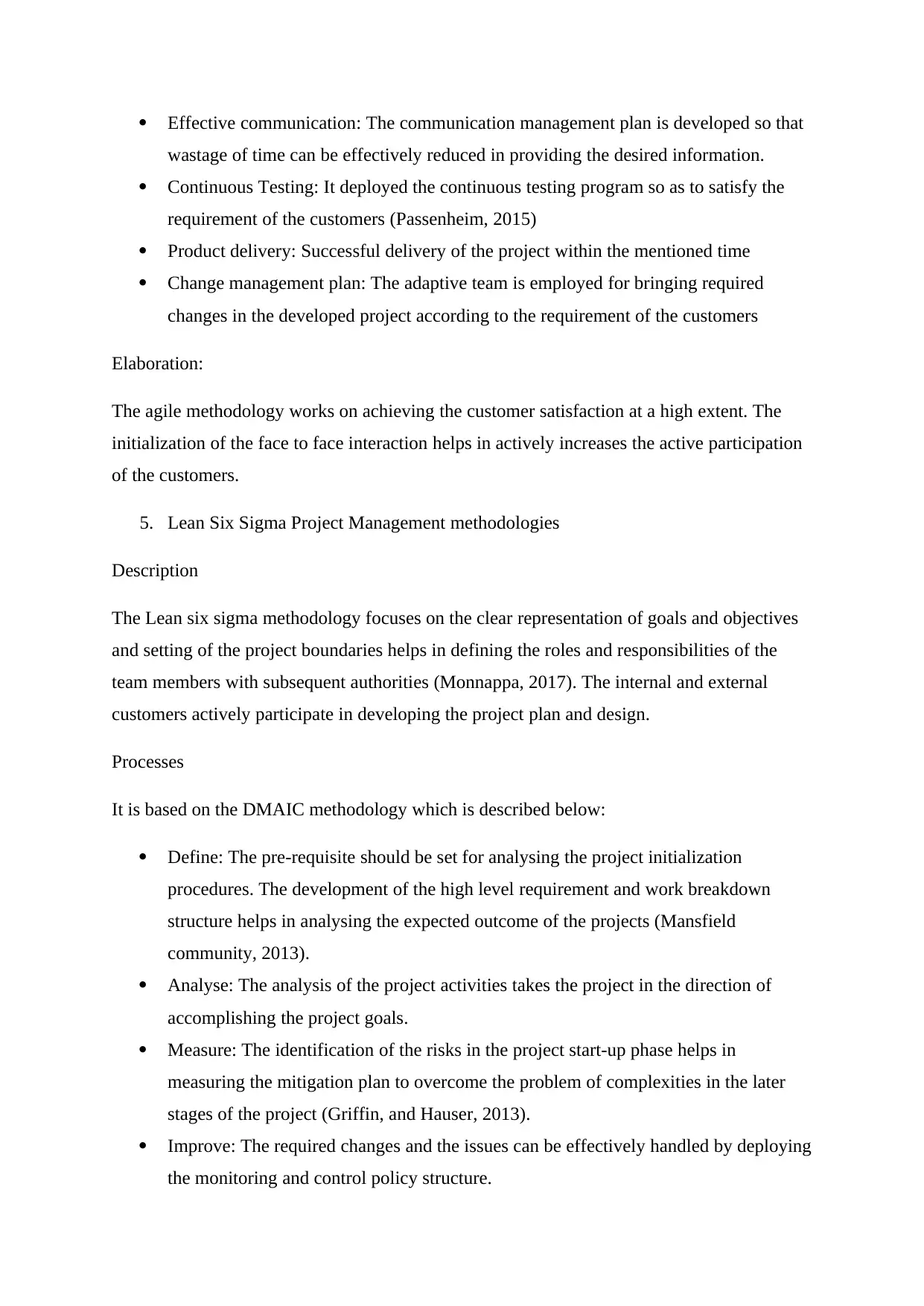
Effective communication: The communication management plan is developed so that
wastage of time can be effectively reduced in providing the desired information.
Continuous Testing: It deployed the continuous testing program so as to satisfy the
requirement of the customers (Passenheim, 2015)
Product delivery: Successful delivery of the project within the mentioned time
Change management plan: The adaptive team is employed for bringing required
changes in the developed project according to the requirement of the customers
Elaboration:
The agile methodology works on achieving the customer satisfaction at a high extent. The
initialization of the face to face interaction helps in actively increases the active participation
of the customers.
5. Lean Six Sigma Project Management methodologies
Description
The Lean six sigma methodology focuses on the clear representation of goals and objectives
and setting of the project boundaries helps in defining the roles and responsibilities of the
team members with subsequent authorities (Monnappa, 2017). The internal and external
customers actively participate in developing the project plan and design.
Processes
It is based on the DMAIC methodology which is described below:
Define: The pre-requisite should be set for analysing the project initialization
procedures. The development of the high level requirement and work breakdown
structure helps in analysing the expected outcome of the projects (Mansfield
community, 2013).
Analyse: The analysis of the project activities takes the project in the direction of
accomplishing the project goals.
Measure: The identification of the risks in the project start-up phase helps in
measuring the mitigation plan to overcome the problem of complexities in the later
stages of the project (Griffin, and Hauser, 2013).
Improve: The required changes and the issues can be effectively handled by deploying
the monitoring and control policy structure.
wastage of time can be effectively reduced in providing the desired information.
Continuous Testing: It deployed the continuous testing program so as to satisfy the
requirement of the customers (Passenheim, 2015)
Product delivery: Successful delivery of the project within the mentioned time
Change management plan: The adaptive team is employed for bringing required
changes in the developed project according to the requirement of the customers
Elaboration:
The agile methodology works on achieving the customer satisfaction at a high extent. The
initialization of the face to face interaction helps in actively increases the active participation
of the customers.
5. Lean Six Sigma Project Management methodologies
Description
The Lean six sigma methodology focuses on the clear representation of goals and objectives
and setting of the project boundaries helps in defining the roles and responsibilities of the
team members with subsequent authorities (Monnappa, 2017). The internal and external
customers actively participate in developing the project plan and design.
Processes
It is based on the DMAIC methodology which is described below:
Define: The pre-requisite should be set for analysing the project initialization
procedures. The development of the high level requirement and work breakdown
structure helps in analysing the expected outcome of the projects (Mansfield
community, 2013).
Analyse: The analysis of the project activities takes the project in the direction of
accomplishing the project goals.
Measure: The identification of the risks in the project start-up phase helps in
measuring the mitigation plan to overcome the problem of complexities in the later
stages of the project (Griffin, and Hauser, 2013).
Improve: The required changes and the issues can be effectively handled by deploying
the monitoring and control policy structure.
Paraphrase This Document
Need a fresh take? Get an instant paraphrase of this document with our AI Paraphraser
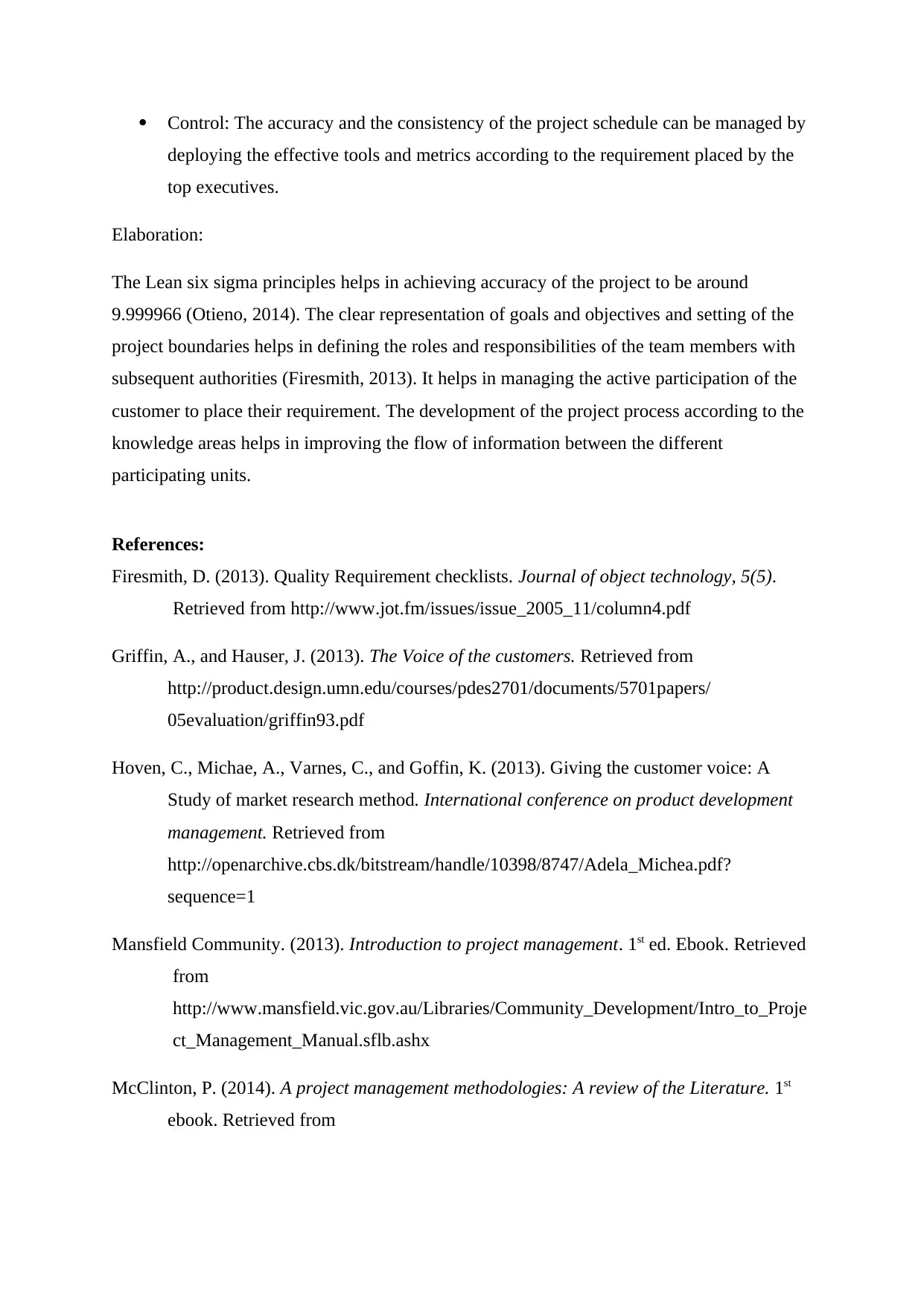
Control: The accuracy and the consistency of the project schedule can be managed by
deploying the effective tools and metrics according to the requirement placed by the
top executives.
Elaboration:
The Lean six sigma principles helps in achieving accuracy of the project to be around
9.999966 (Otieno, 2014). The clear representation of goals and objectives and setting of the
project boundaries helps in defining the roles and responsibilities of the team members with
subsequent authorities (Firesmith, 2013). It helps in managing the active participation of the
customer to place their requirement. The development of the project process according to the
knowledge areas helps in improving the flow of information between the different
participating units.
References:
Firesmith, D. (2013). Quality Requirement checklists. Journal of object technology, 5(5).
Retrieved from http://www.jot.fm/issues/issue_2005_11/column4.pdf
Griffin, A., and Hauser, J. (2013). The Voice of the customers. Retrieved from
http://product.design.umn.edu/courses/pdes2701/documents/5701papers/
05evaluation/griffin93.pdf
Hoven, C., Michae, A., Varnes, C., and Goffin, K. (2013). Giving the customer voice: A
Study of market research method. International conference on product development
management. Retrieved from
http://openarchive.cbs.dk/bitstream/handle/10398/8747/Adela_Michea.pdf?
sequence=1
Mansfield Community. (2013). Introduction to project management. 1st ed. Ebook. Retrieved
from
http://www.mansfield.vic.gov.au/Libraries/Community_Development/Intro_to_Proje
ct_Management_Manual.sflb.ashx
McClinton, P. (2014). A project management methodologies: A review of the Literature. 1st
ebook. Retrieved from
deploying the effective tools and metrics according to the requirement placed by the
top executives.
Elaboration:
The Lean six sigma principles helps in achieving accuracy of the project to be around
9.999966 (Otieno, 2014). The clear representation of goals and objectives and setting of the
project boundaries helps in defining the roles and responsibilities of the team members with
subsequent authorities (Firesmith, 2013). It helps in managing the active participation of the
customer to place their requirement. The development of the project process according to the
knowledge areas helps in improving the flow of information between the different
participating units.
References:
Firesmith, D. (2013). Quality Requirement checklists. Journal of object technology, 5(5).
Retrieved from http://www.jot.fm/issues/issue_2005_11/column4.pdf
Griffin, A., and Hauser, J. (2013). The Voice of the customers. Retrieved from
http://product.design.umn.edu/courses/pdes2701/documents/5701papers/
05evaluation/griffin93.pdf
Hoven, C., Michae, A., Varnes, C., and Goffin, K. (2013). Giving the customer voice: A
Study of market research method. International conference on product development
management. Retrieved from
http://openarchive.cbs.dk/bitstream/handle/10398/8747/Adela_Michea.pdf?
sequence=1
Mansfield Community. (2013). Introduction to project management. 1st ed. Ebook. Retrieved
from
http://www.mansfield.vic.gov.au/Libraries/Community_Development/Intro_to_Proje
ct_Management_Manual.sflb.ashx
McClinton, P. (2014). A project management methodologies: A review of the Literature. 1st
ebook. Retrieved from
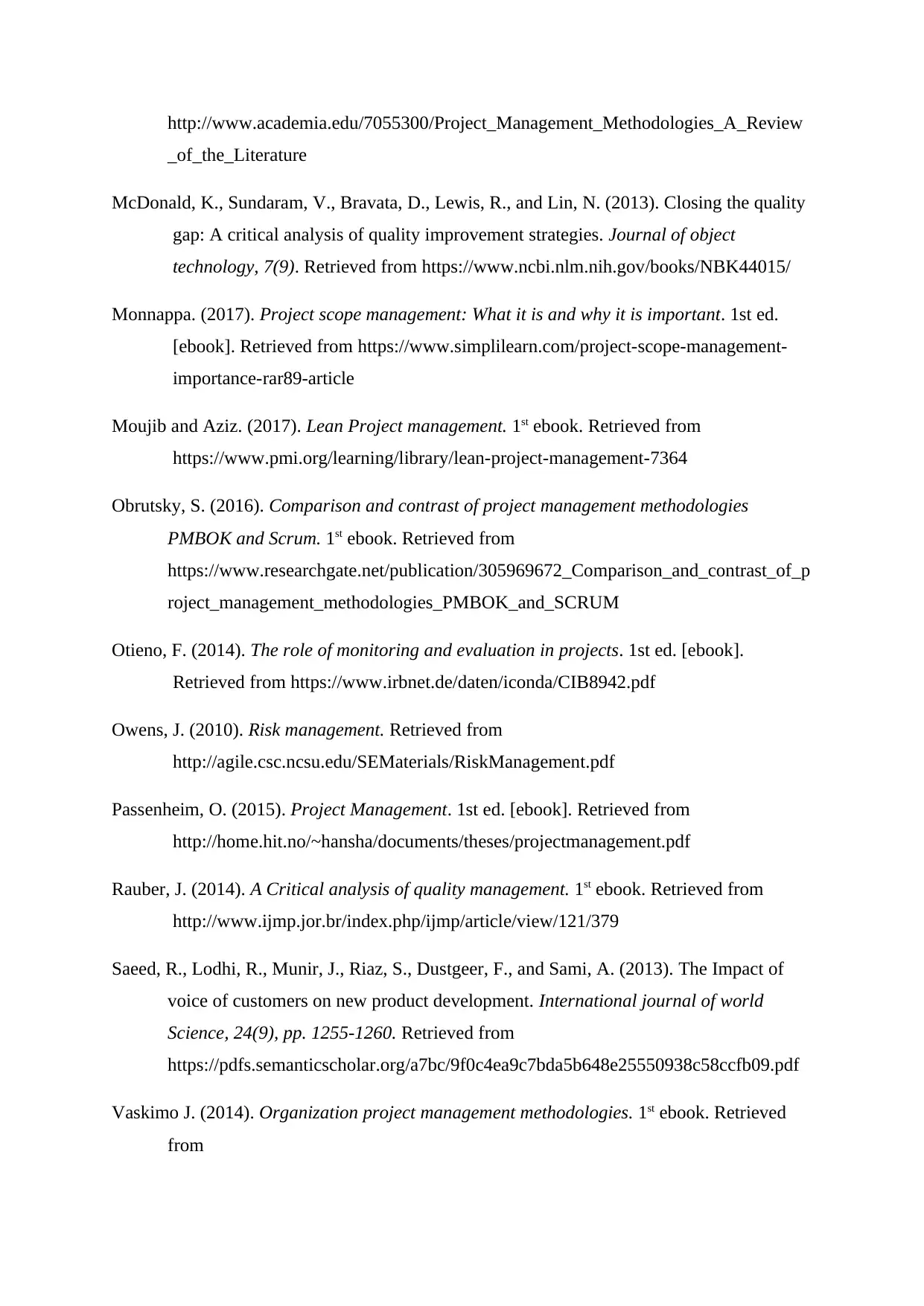
http://www.academia.edu/7055300/Project_Management_Methodologies_A_Review
_of_the_Literature
McDonald, K., Sundaram, V., Bravata, D., Lewis, R., and Lin, N. (2013). Closing the quality
gap: A critical analysis of quality improvement strategies. Journal of object
technology, 7(9). Retrieved from https://www.ncbi.nlm.nih.gov/books/NBK44015/
Monnappa. (2017). Project scope management: What it is and why it is important. 1st ed.
[ebook]. Retrieved from https://www.simplilearn.com/project-scope-management-
importance-rar89-article
Moujib and Aziz. (2017). Lean Project management. 1st ebook. Retrieved from
https://www.pmi.org/learning/library/lean-project-management-7364
Obrutsky, S. (2016). Comparison and contrast of project management methodologies
PMBOK and Scrum. 1st ebook. Retrieved from
https://www.researchgate.net/publication/305969672_Comparison_and_contrast_of_p
roject_management_methodologies_PMBOK_and_SCRUM
Otieno, F. (2014). The role of monitoring and evaluation in projects. 1st ed. [ebook].
Retrieved from https://www.irbnet.de/daten/iconda/CIB8942.pdf
Owens, J. (2010). Risk management. Retrieved from
http://agile.csc.ncsu.edu/SEMaterials/RiskManagement.pdf
Passenheim, O. (2015). Project Management. 1st ed. [ebook]. Retrieved from
http://home.hit.no/~hansha/documents/theses/projectmanagement.pdf
Rauber, J. (2014). A Critical analysis of quality management. 1st ebook. Retrieved from
http://www.ijmp.jor.br/index.php/ijmp/article/view/121/379
Saeed, R., Lodhi, R., Munir, J., Riaz, S., Dustgeer, F., and Sami, A. (2013). The Impact of
voice of customers on new product development. International journal of world
Science, 24(9), pp. 1255-1260. Retrieved from
https://pdfs.semanticscholar.org/a7bc/9f0c4ea9c7bda5b648e25550938c58ccfb09.pdf
Vaskimo J. (2014). Organization project management methodologies. 1st ebook. Retrieved
from
_of_the_Literature
McDonald, K., Sundaram, V., Bravata, D., Lewis, R., and Lin, N. (2013). Closing the quality
gap: A critical analysis of quality improvement strategies. Journal of object
technology, 7(9). Retrieved from https://www.ncbi.nlm.nih.gov/books/NBK44015/
Monnappa. (2017). Project scope management: What it is and why it is important. 1st ed.
[ebook]. Retrieved from https://www.simplilearn.com/project-scope-management-
importance-rar89-article
Moujib and Aziz. (2017). Lean Project management. 1st ebook. Retrieved from
https://www.pmi.org/learning/library/lean-project-management-7364
Obrutsky, S. (2016). Comparison and contrast of project management methodologies
PMBOK and Scrum. 1st ebook. Retrieved from
https://www.researchgate.net/publication/305969672_Comparison_and_contrast_of_p
roject_management_methodologies_PMBOK_and_SCRUM
Otieno, F. (2014). The role of monitoring and evaluation in projects. 1st ed. [ebook].
Retrieved from https://www.irbnet.de/daten/iconda/CIB8942.pdf
Owens, J. (2010). Risk management. Retrieved from
http://agile.csc.ncsu.edu/SEMaterials/RiskManagement.pdf
Passenheim, O. (2015). Project Management. 1st ed. [ebook]. Retrieved from
http://home.hit.no/~hansha/documents/theses/projectmanagement.pdf
Rauber, J. (2014). A Critical analysis of quality management. 1st ebook. Retrieved from
http://www.ijmp.jor.br/index.php/ijmp/article/view/121/379
Saeed, R., Lodhi, R., Munir, J., Riaz, S., Dustgeer, F., and Sami, A. (2013). The Impact of
voice of customers on new product development. International journal of world
Science, 24(9), pp. 1255-1260. Retrieved from
https://pdfs.semanticscholar.org/a7bc/9f0c4ea9c7bda5b648e25550938c58ccfb09.pdf
Vaskimo J. (2014). Organization project management methodologies. 1st ebook. Retrieved
from
⊘ This is a preview!⊘
Do you want full access?
Subscribe today to unlock all pages.

Trusted by 1+ million students worldwide
1 out of 13
Related Documents
Your All-in-One AI-Powered Toolkit for Academic Success.
+13062052269
info@desklib.com
Available 24*7 on WhatsApp / Email
![[object Object]](/_next/static/media/star-bottom.7253800d.svg)
Unlock your academic potential
Copyright © 2020–2025 A2Z Services. All Rights Reserved. Developed and managed by ZUCOL.
